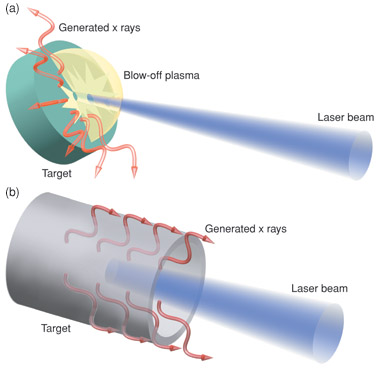
What is Laser
Introduction:
In 1917, Albert Einstein was the first one to propose the “stimulated emissions” concept, which turned out to be the basic concept of Laser. Later in the 1950's, practical research were performed on applying this concept “stimulated emission” to make lasers. It wasn't until 1960 that the first laser was made by Theodore Maimam, out of synthetic ruby (7)
Laser stands for “light amplification by stimulated emission of radiation”. Laser is a unique kind of light which differs from white light. While light from most sources travels farther from its origin, starts to spread out and becomes less intense, laser light doesn't disperse and last much farther. Laser light has a single wavelength, “monochromatic”, which corresponds to only one specific color; identical wavelengths reinforcement each other, and travel parallel to one another, creating strong focused beam.(2)

https://www.llnl.gov/str/October05/gifs/Fournier1.jpg
Laser Beam
A photon's position on the electromagnetic spectrum depends on its frequency, and Laser emits light of the same frequency and polarity (Polarized light oscillates all in one direction).

http://www.geocities.com/muldoon432/how_a_laser_works.htm
The Electromagnetic Spectrum and Quantum Energy
Creating Laser beam:
There are three main components to create laser; a gain medium, an energy pump, and resonant optical cavity. (3)
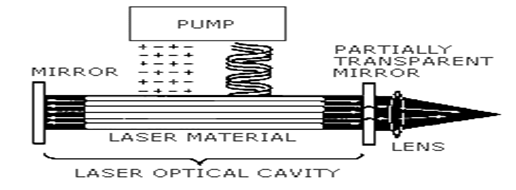
http://www.geocities.com/muldoon432/how_a_laser_works.htm
Laser components
1-Gain medium:
Can be solid, liquid, or gas, specific type of Laser depends on the gain medium, and whether the Laser is operated continuously or pulsed. (4) Gain medium usually made up of a uniform material that is stimulated to release a photon, as another photon passes by, it causes an outer electron on an atom of a gain medium to fall back to a lower energy state to emit a second photon of the same frequency and the light is amplified. (5)
2- Energy pump:
Source of energy used to excite the gain medium. Main types of sources being used are electricity, flash tubes, lamps, or energy from another laser. (6)
3- Resonant optical cavity:
Has two mirrors, one fully reflective, and the other partially reflective. The released amplified light (photons) bounces back and forth between the two mirrors (resonating), bumping more electrons into the gain medium and releasing more photons. The main purpose of the partially reflective mirror is to allow some of the light to eventually escape creating a Laser beam. Figure 1 illustrates the amplification that occurs within the resonant cavity due to the mirrors at each end. Figure 1(a) shows the beginning of stimulated emission,ending with Figure (h) where the cavity is saturated with stimulated emission.(18)
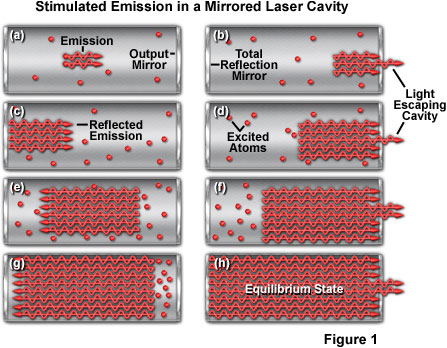
http://micro.magnet.fsu.edu/primer/java/lasers/heliumneonlaser/index.html
Laser Energy Levels (Boltzmann)
There are two methods to produce a population inversion, either by stimulating more atoms or molecules into a higher energy state, or by reducing the population of a lower energy state. Only adding energy by thermally exciting the medium is not sufficient to produce a population inversion, because heat only increases the average energy of the population, but does not increase the number of species in the excited state compared to these in the lower state. The ratio of the atoms at two energy levels is given by Boltzmann equation
N 2 /N 1 = exp[- (E 2 - E 1 ) / kT]where N(1)and N(2) are the number of atoms in level 1 and level 2, respectively, E(1) and E(2) are the energies of the two levels, K is the Boltzmann constant, and T is the temperature in kelvin's. (18)
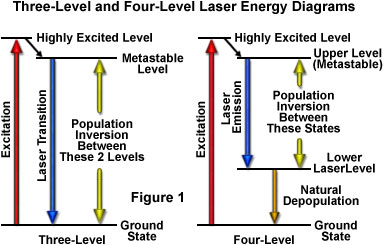
http://micro.magnet.fsu.edu/primer/java/lasers/stimulatedemission/index.html
To have the targeted population inversion for laser activity, atoms or molecules must be selectively excited to specific energy levels. Either light or electrons could be used as source of energy.(18)
Laser Spectrum:
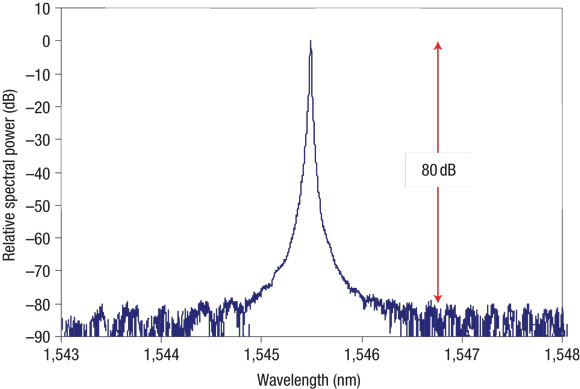
http://www.nature.com/nphoton/journal/v1/n4/images/nphoton.2007.29-f5.jpg
The laser spectrum was measured with a grating-based optical spectrum analyzer with a resolution of 0.01 nm, showing single-mode lasing with side-mode suppression of >80 dB (20)
http://www.nature.com/nphoton/journal/v1/n4/images/nphoton.2007.29-f5.jpg
Solid State Laser Spectrum
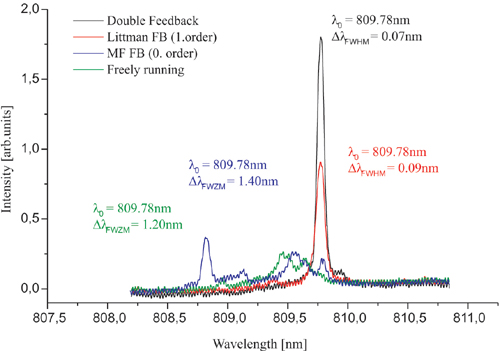
http://www.risoe.dk/Research/sustainable_energy/new_energy_technologies/projects/~/media/risoe_dk/research/diode_laser/images/double_02_spec.ashx
Spectrum of the double and single feedback laser.
Black spectrum: Double feedback applied; Red spectrum: Feedback from first order applied; Blue spectrum: Feedback from zeroth order applied; Green spectrum: Freely running laser.(21)